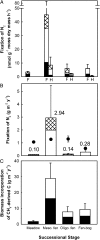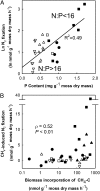Methanotrophy induces nitrogen fixation during peatland development
- PMID: 24379382
- PMCID: PMC3896166
- DOI: 10.1073/pnas.1314284111
Methanotrophy induces nitrogen fixation during peatland development
Abstract
Nitrogen (N) accumulation rates in peatland ecosystems indicate significant biological atmospheric N2 fixation associated with Sphagnum mosses. Here, we show that the linkage between methanotrophic carbon cycling and N2 fixation may constitute an important mechanism in the rapid accumulation of N during the primary succession of peatlands. In our experimental stable isotope enrichment study, previously overlooked methane-induced N2 fixation explained more than one-third of the new N input in the younger peatland stages, where the highest N2 fixation rates and highest methane oxidation activities co-occurred in the water-submerged moss vegetation.
Keywords: CH4; diazotrophy; mire; peat; phosphorus.
Conflict of interest statement
The authors declare no conflict of interest.
Figures




Similar articles
-
Climate drivers alter nitrogen availability in surface peat and decouple N2 fixation from CH4 oxidation in the Sphagnum moss microbiome.Glob Chang Biol. 2023 Jun;29(11):3159-3176. doi: 10.1111/gcb.16651. Epub 2023 Mar 31. Glob Chang Biol. 2023. PMID: 36999440
-
Microbial nitrogen fixation and methane oxidation are strongly enhanced by light in Sphagnum mosses.AMB Express. 2020 Mar 31;10(1):61. doi: 10.1186/s13568-020-00994-9. AMB Express. 2020. PMID: 32236738 Free PMC article.
-
Significant nonsymbiotic nitrogen fixation in Patagonian ombrotrophic bogs.Glob Chang Biol. 2015 Jun;21(6):2357-65. doi: 10.1111/gcb.12849. Epub 2015 Mar 6. Glob Chang Biol. 2015. PMID: 25545459
-
Sphagnum mosses, the impact of disturbances and anthropogenic management actions on their ecological role in CO2 fluxes generated in peatland ecosystems.Glob Chang Biol. 2024 Jan;30(1):e16972. doi: 10.1111/gcb.16972. Epub 2023 Oct 26. Glob Chang Biol. 2024. PMID: 37882506 Review.
-
The Sphagnum microbiome: new insights from an ancient plant lineage.New Phytol. 2016 Jul;211(1):57-64. doi: 10.1111/nph.13993. Epub 2016 May 13. New Phytol. 2016. PMID: 27173909 Review.
Cited by
-
Diazotroph community structure in the deep oxygen minimum zone of the Costa Rica Dome.J Plankton Res. 2016 Mar;38(2):380-391. doi: 10.1093/plankt/fbw003. Epub 2016 Feb 16. J Plankton Res. 2016. PMID: 27275037 Free PMC article.
-
Microbial community dynamics in two Central European peatlands affected by different nitrogen depositions.FEMS Microbiol Ecol. 2025 Jun 24;101(7):fiaf056. doi: 10.1093/femsec/fiaf056. FEMS Microbiol Ecol. 2025. PMID: 40478762 Free PMC article.
-
The influence of oxygen and methane on nitrogen fixation in subarctic Sphagnum mosses.AMB Express. 2018 May 5;8(1):76. doi: 10.1186/s13568-018-0607-2. AMB Express. 2018. PMID: 29730829 Free PMC article.
-
Bog ecosystems as a playground for plant-microbe coevolution: bryophytes and vascular plants harbour functionally adapted bacteria.Microbiome. 2021 Aug 11;9(1):170. doi: 10.1186/s40168-021-01117-7. Microbiome. 2021. PMID: 34380552 Free PMC article.
-
Recovery of fen peatland microbiomes and predicted functional profiles after rewetting.ISME J. 2020 Jul;14(7):1701-1712. doi: 10.1038/s41396-020-0639-x. Epub 2020 Apr 3. ISME J. 2020. PMID: 32242082 Free PMC article.
References
-
- Gorham E. Northern peatlands: Role in the carbon cycle and probable responses to climatic warming. Ecol Appl. 1991;1(2):182–195. - PubMed
-
- Tarnocai C, et al. Soil organic carbon pools in the northern circumpolar permafrost region. Global Biogeochem Cycles. 2009;23 doi: 10.1029/2008GB003327. - DOI
-
- Raghoebarsing AA, et al. Methanotrophic symbionts provide carbon for photosynthesis in peat bogs. Nature. 2005;436(7054):1153–1156. - PubMed
-
- Larmola T, et al. The role of Sphagnum mosses in the methane cycling of a boreal mire. Ecology. 2010;91(8):2356–2365. - PubMed
-
- Aerts R, Wallen B, Malmer N. Growth-limiting nutrients in Sphagnum-dominated bogs subject to low and high atmospheric nitrogen supply. J Ecol. 1992;80(1):131–140.
Publication types
MeSH terms
Substances
LinkOut - more resources
Full Text Sources
Other Literature Sources

